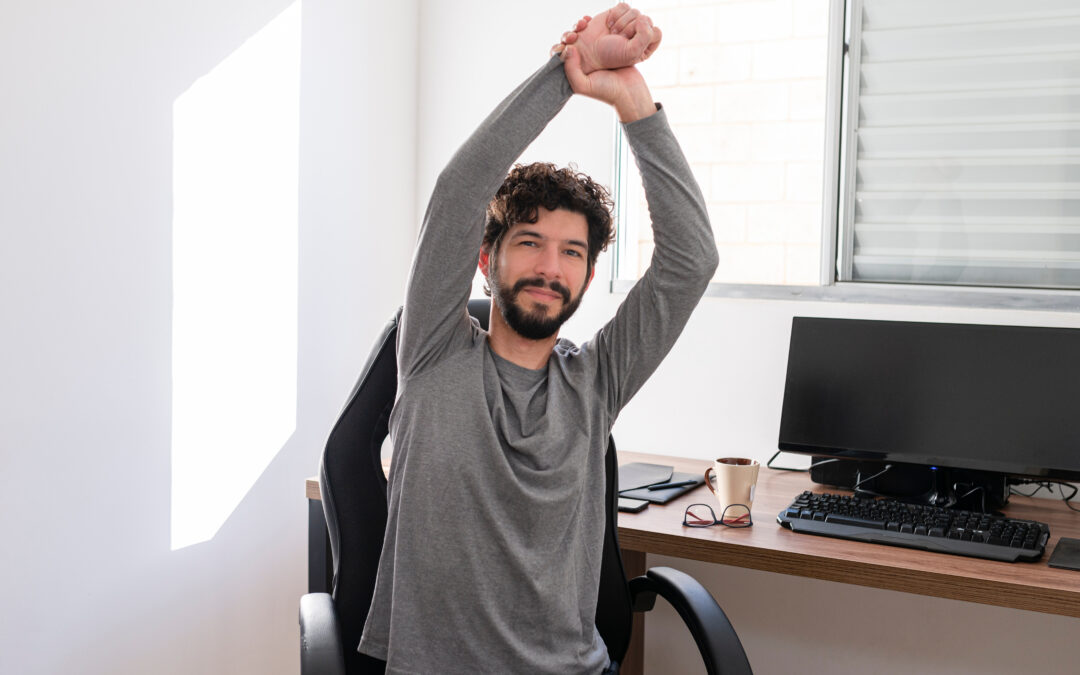Research has linked sitting for long periods with many health concerns. It raises the risk of heart disease, diabetes, stroke, high blood pressure and high cholesterol, which all play a role in the condition.
For people required to sit at work for long periods of time, there are simple exercises you can do to improve overall body health.
Hands
These may be the easiest exercises to begin with, even if you work in a confined space. They are especially crucial for people who spend hours working on computers.
- Finger stretches: Put index fingers on the edge of the desk. Keep wrists straight and gently push your finger into the desk and hold. Breathe deeply. Repeat with all fingers. It is important not to stretch the thumbs using this method.
- Thumb stretches: Put your right palm on the top of your desk. Keeping your wrist straight, relax all of your fingers. With your left hand, stretch the thumb away from your forefinger as comfortably as possible. Hold and breathe deeply. Release and then repeat with the other thumb.
- Hand stretches: Make fists and tense the muscles in your hands, then relax. Next, spread and stretch your fingers as wide as possible, then relax.
- Hand grips: Get a hand grip or stress ball; squeeze it at times throughout the day to strengthen forearm muscles and relieve hand stress.
- Wrist rolls: Regularly roll the wrists to help prevent carpal tunnel syndrome and improve blood circulation.
Neck
- Neck rolls: Drop the chin and slowly and carefully roll your neck. Raise the chin up and slowly bend your neck to each side, trying to touch each ear to the corresponding shoulder without raising the shoulders. This exercise helps lessen tension and neck strain.
- Shrug shoulder: At least three times a day, pull your shoulders up to your ears, release the tension and drop your shoulders.
- Shoulder rolls: Roll your shoulders forward and then roll them backward. This helps relieve the tension in the shoulder and upper back muscles.
Feet and legs
- Ankle rolls: While sitting, lift each leg slightly and roll each ankle. This helps improve blood circulation. It can also help prevent the tingling feeling that occurs when blood circulation is cut off.
- Raise toes: Keep your heels on the ground while seated and lift your toes. This helps blood circulation to the feet. If you can stand, this exercise works best in a standing position.
- Calf stretches: Put both legs in front of you while sitting. Lift both legs on the balls of the feet and set them down. Rest when your calves are tired, and then repeat. Do three repetitions at various points throughout the day.
- Hip flexes: While sitting in a chair, lift one foot slightly off the floor. Keep the knee bent in a 90-degree angle, and hold the position for as long as possible. This helps strengthen thigh muscles.
Torso
- Twist: Sit up straight and place your left arm behind your right hip. Twist to the left and hold. Do this again with your right arm and hip. You should feel the muscles on your sides and back stretch.
- Tone abs: While sitting, take a deep breath in, suck in your stomach, hold the position, and then release slowly. Repeat a number of times to strengthen the core. When abs are more toned, this takes the pressure off of back muscles.
- Reverse stretch: People who sit at a desk all day tend to hunch forward. Counter that position with backward stretches. Open your arms wide, rotate your wrists, so both thumbs point up and backward, and then pull your shoulders back. You should feel the muscles stretch in your shoulders and upper chest.
- Get on the ball: If allowed in your work space, consider purchasing a large-size stability ball or stability ball-style desk chair. This helps keep the back straight and abs engaged.
Overall stretch
It is important to get up from your chair at least every half hour to stretch or walk around. This helps prevent blood clots from developing in the legs, which are very common among middle-aged workers who sit for long periods of time.
While standing, take a few moments to reach forward to the sides and above your head to stretch your arms. These simple stretches help prevent stiffness, relax the muscles and avoid pinched nerves and other complications from tense muscles.
Explore Mindstream™ , a fitness studio for your mind, to strengthen your emotional health, learn ways to reduce stress, cope with anxiety and more.
Source: SupportLinc

